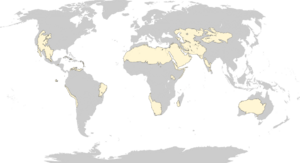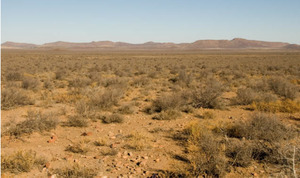Deserts and xeric shrublands facts for kids
Deserts and dry shrublands are a special type of biome. A biome is a large area on Earth with similar plants, animals, and climate. The World Wide Fund for Nature (WWF) helps us understand these areas. These dry lands cover about 19% of Earth's land, making them the largest land biome!
These places don't get much rain, usually less than 250 millimeters (10 inches) each year. In fact, more water evaporates from the land than falls as rain. Temperatures can also change a lot. Some deserts, like the Sahara, are hot all year. But others, like the Gobi Desert in Asia, get very cold in winter.
Most deserts have big temperature swings. Days are super hot, but nights get very cold. This happens because there isn't much moisture or cloud cover to keep the heat in. Even though conditions are tough, many different kinds of plants and animals live here. Many plants have special ways to save water. Animals are also well-adapted to these dry conditions.
What is Desertification?
Sometimes, land that used to be productive and green turns into desert. This process is called desertification. It can happen for several reasons.
One big reason is human activity. For example, if farmers use the land too much, or if too many animals eat all the plants (this is called overgrazing), the soil can become damaged. It then becomes harder for plants to grow back.
Changes in climate can also cause desertification. Things like global warming can make some areas drier. Natural cycles, like the Milankovitch cycle, which cause ice ages and warmer periods, also affect where deserts form on Earth.
Amazing Desert Regions
The World Wide Fund for Nature (WWF) has pointed out some special desert regions. These areas have a lot of different plants and animals, and many of them are found nowhere else on Earth. This is called endemism.
Here are a few examples:
- The Nama Karoo in Namibia has the most different kinds of desert animals in the world.
- The Chihuahuan desert and Central Mexican matorral are the richest deserts in the Americas.
- The Carnarvon xeric shrublands in Australia are a special place where many unique plants and animals live.
- The Sonoran Desert and Baja California Desert in Mexico are unusual. They have huge, tall cacti that look like columns.
- The Madagascar spiny forests are unique forests with thorny plants.
- The Atacama Desert is one of the driest places on Earth.
See also
 In Spanish: Matorral xerófilo para niños
In Spanish: Matorral xerófilo para niños



